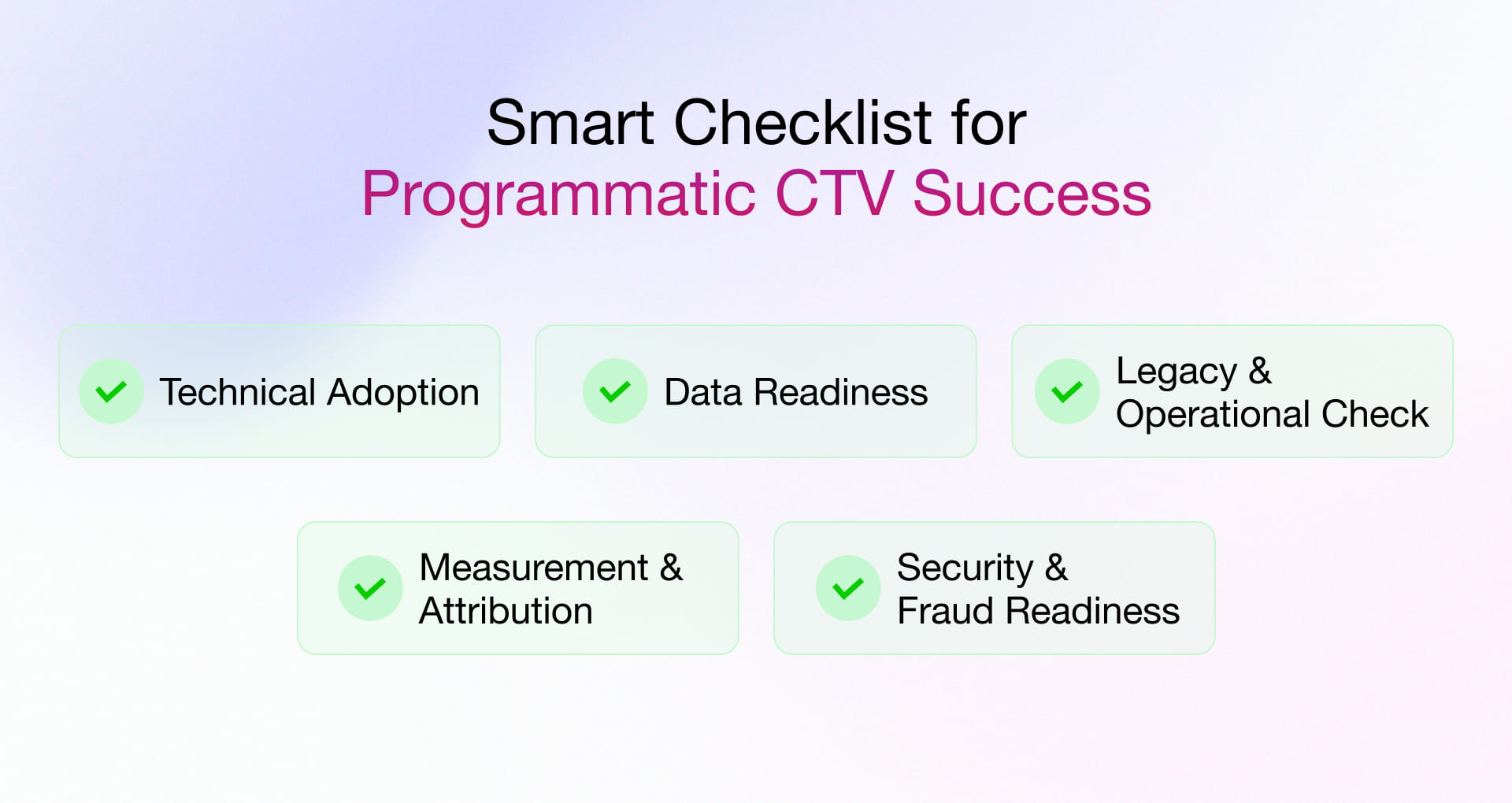The convergence of data intelligence, digital media, and advertising technology has transformed Connected TV (CTV) from a niche digital extension into a cornerstone of omnichannel strategy. As advertisers reallocate budgets across a fragmented media landscape, including linear TV, mobile, OTT, and digital, programmatic CTV uniquely bridges the gap between the precision of digital targeting and the expansive reach of television.
Over this series, we’ve explored the fundamentals of programmatic CTV for advertisers and publishers, delved into the role of advanced analytics in driving programmatic success, and examined the build vs. buy dilemma for programmatic CTV platforms. Now, we turn to the missing piece: infrastructure readiness.
Unlocking programmatic success requires more than creative flexibility; it demands an IT infrastructure built for real-time orchestration, scalable personalization, and integrated performance measurement
Traditional architectures characterized by siloed data, rigid pipelines, and outdated attribution models—are increasingly inadequate. Recent research highlights the critical role of IT infrastructure as a strategic enabler, linking data-driven advertising initiatives to measurable business outcomes. Technology adoption alone falls short unless paired with a clear understanding of infrastructure maturity. Enterprises that assess and evolve their systems through an AdTech-first lens are better positioned to activate behavioral insights and maximize campaign ROI across every digital touchpoint.
So, is your infrastructure ready to operationalize programmatic CTV at scale? Let’s explore the key factors that should be on your readiness checklist.
Why Programmatic CTV Infrastructure Readiness Matters?
Programmatic CTV infrastructure readiness is no longer optional—it’s non-negotiable. Yes, you heard that right. In the years ahead, organizations with mature, purpose-built programmatic CTV infrastructure are expected to outperform significantly in both ad-driven revenue and audience engagement KPIs.
Forward-thinking brands, agencies, and media organizations understand that infrastructure isn’t just a backend; it’s a critical driver of growth and monetization. Legacy architecture designed for linear broadcasting or manually operated digital campaigns falls short in today’s real-time, data-intensive environment. They lack the precision, speed, and flexibility needed to compete.
In contrast, a programmatic-ready CTV infrastructure enables:
- Faster Monetization: Automated, streamlined connections between supply and demand reduce manual workflows and accelerate revenue generation.
- Targeted Reach: Integration of first- and third-party data enables smarter, hyper-personalized campaigns that deliver measurable results.
- Scalability: Resilient platforms can scale seamlessly to accommodate growing audiences and demand spikes—without compromising performance.
The Hidden Costs of Under-Optimized Infrastructure for Programmatic CTV
An under-optimized infrastructure doesn’t just slow you down—it directly impacts revenue, engagement, and ROI. Below are key challenges and the business consequences that often follow:
| Challenges | Business Impact |
| Manual Buys & Limited Automation | Slower campaign execution, missed impression opportunities, and reduced profit margins |
| Disjointed Systems | Fragmented audience data, longer setup cycles, and isolated insights across platforms. |
| Lack of Frequency Controls | Ad fatigue, wasted impressions, and diminished user experience. |
| Inefficient Pathing | Lost conversion opportunities due to poor sequencing across CTV and other channels. |
The Limitations of Traditional TV and Basic CTV Buying
While Connected TV offers exciting potential, not all CTV strategies are created equal. Many organizations still rely on legacy approaches or limited implementations that fall short of what programmatic can deliver. Consider the following limitations:
- Legacy TV Advertising: High media costs, broad demographic targeting, and no real-time optimization make it challenging to justify ROI in today’s data-driven landscape.
- Manual CTV Buys: Lack of automation and scalability hampers execution, while imprecise targeting and opaque measurement reduce effectiveness.
- Non-Programmatic CTV: Without programmatic capabilities, advertisers miss out on automated bidding, dynamic creative optimization (DCO), and closed-loop attribution—core pillars of modern performance marketing.
Mature programmatic CTV systems turn media buying and selling into a real-time, data-driven engine for sustained revenue growth. The organizations that act now—aligning their technical infrastructure with both near-term goals and long-term vision—will be the ones leading the charge, not catching up.
Checklist for Programmatic CTV Success
The revenue-driven approach of programmatic CTV advertising lies in its ability to automate media buying, personalize delivery, and optimize performance in real-time. Without the proper infrastructure, brands risk fragmented execution, limited optimization, and higher costs per acquisition. Infrastructure serves as the backbone for advertisers and publishers, enabling data-driven decisions within milliseconds and navigating the complexities of today’s advertising ecosystem.
Below are the key elements of programmatic CTV infrastructure that deserve close attention to ensure long-term scalability and effectiveness.

Technical Adoption
To enable real-time bidding and automated trading of CTV ad inventory, your infrastructure must integrate multiple components and platforms for seamless operation. This includes:
- Deploying video-capable ad servers
- Configuring SSPs for pod-based inventory packaging
- Establishing DSP integrations that support real-time transactions
Identity resolution should move beyond cookies, leveraging IP-based IDs, household graphs, and first-party data for deterministic targeting. Server-side ad Insertion (SSAI) is critical for delivering broadcast-quality experiences and accurate measurement.
Your tech stack must comply with privacy regulations (GDPR, CCPA, COPPA) and support scalable analytics for impression validation, attribution, and real-time performance tracking. Every layer needs to be built for interoperability and high throughput to enable reliable, large-scale programmatic delivery.
Programmatic CTV is unforgiving—your AdTech business must be technically fluent or risk being left behind.
Data Readiness:
Data is the fuel of programmatic CTV—but are you feeding your systems with clean, consented, and connected signals?
Real data readiness means:
- Real-time ingestion and enrichment pipelines—not slow batch ETL jobs. You must process live audience signals like device IDs, content engagement, geolocation, and household profiles.
- Privacy-first architecture – with regulations like CCPA and GDPR, automatic consent handling, opt-out management, and audit-ready logs are essential.
- Seamless interoperability. Your data needs to flow smoothly between SSPs and DSPs in real-time. If you’re stuck translating formats mid-flight, performance and revenue will suffer.
Without a strong data infrastructure that keeps pace with targeting demands, you risk system failures or, worse, losing client trust.
Legacy and Operational Validation
This is where most companies quietly stumble. Older systems may function but aren’t built for programmatic velocity. Ask yourself:
- Can your CMS and ad servers handle rapid creative swaps, real-time dynamic pod generation, and multiple fallback logics per user session?
- Do your teams have real-time logs, alerting, and UI-based campaign controls—or are they stuck with manual reports, delayed post-buys, and CSV exports?
- How quickly can your infrastructure and team pivot if targeting needs to change mid-campaign? If the answer is “after 24 hours,” you’re already too slow to win.
It’s not enough for your stack to “work.” It must keep pace with the fast-moving AdTech market and empower your teams, not hinder them.
Measurement & Attribution
Programmatic CTV measurement is complex due to its fragmented nature, but buyers demand real outcomes, not just impressions. When planning your programmatic CTV infrastructure, you need to include:
- Third-party integrations (Nielsen, Comscore, Innovid, etc.) for impression validation and audience reach.
- Multi-touch attribution that connects big-screen ad views with actions on mobile, desktop, or in-store visits.
- Event-level data tracking—capturing viewer interactions like skips, rewinds, and session duration, not just start/stop markers.
Without robust measurement capabilities, you can’t optimize campaigns effectively. Worse, you can’t prove their value as a sure way to doom programmatic CTV initiatives.
Security & Fraud Readiness
Fraud in programmatic CTV is silent, costly, and increasingly sophisticated. Without an infrastructure built to detect and respond in real-time, you’re just burning budget—not maximizing value.
- Invalid Traffic (IVT) detection must be proactive, utilizing device fingerprinting, anomaly detection, and pre-bid fraud scoring—not relying on retroactive audits.
- Differentiating real CTV devices from emulators or spoofed traffic is critical, as spoofing is rampant and often undetected.
- Tokenized ad calls, TLS encryption, and secure creative delivery aren’t optional—they’re essential.
Fraudsters evolve faster than ad tech. Your infrastructure needs an adaptive, not reactive, defense strategy.
What Most Businesses Miss (But Can’t Afford To)
Most programmatic CTV strategies fail not because of ambition but because their underlying infrastructure wasn’t engineered to support them. Legacy ad servers can’t handle podded ad requests and real-time transactions. DSPs struggle with decision-making when identity resolution still relies on cookies. And when SSAI is not integrated efficiently, as it should be, measurement breaks down. Inefficient SSAI integration breaks down the measurement. These hidden weaknesses cause latency, misfires, and missed opportunities, draining both performance and revenue.
To build a resilient, revenue-ready programmatic CTV ecosystem, CTOs must treat every layer of the ad stack as critical infrastructure. From rapid bid processing to precise household targeting, every interaction must be fast, compliant, and fully interoperable.
Leadership Decisions That Make or Break Programmatic CTV Success
For CTOs, the real challenge with programmatic CTV isn’t just integrating platforms—it’s ensuring the entire infrastructure can manage real-time complexity, data-driven targeting, and compliance at scale. Every decision—from managing latency to stitching ads into streams—directly impacts revenue and long-term growth.
That’s where we come in.
At Rishabh Software, our specialized AdTech experts can help you build and optimize programmatic CTV systems engineered for performance, scalability, and seamless delivery.
If you’re ready to unlock the full potential of programmatic CTV but unsure where to start or how to lead the transformation, we’re here to help you get it right.
Key Takeaways
- Infrastructure determines your programmatic CTV ROI, not just spend
- Treat your programmatic CTV stack like a SaaS product, not just a media channel
- Privacy, identity resolution, and agility will power your next wave of advertising growth.
- The future of digital advertising is already happening on your customers’ TV screens.











 30 Min
30 Min


